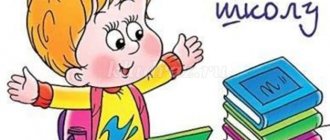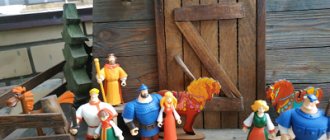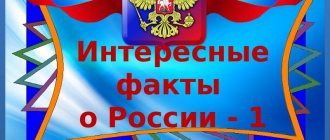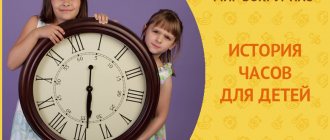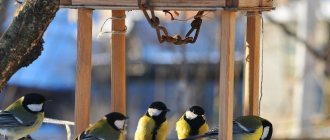Presentation “Heroes of the Russian Land” presentation for the lesson (reading, grade 4) on the topic
Slide 1
Heroes of the Russian land Glory to the Russian side! Glory to Russian antiquity! And I will begin to tell about this antiquity, So that children can know About the affairs of their native land.
Slide 2
Bogatyrs are heroes of Russian epics who performed feats in the name of the Motherland, people of immeasurable strength, perseverance, courage, endowed with extraordinary intelligence and ingenuity. Victor Vasnetsov “Bogatyrs on Horses.” 1896.
Slide 3
Behind the name of each of the epic heroes there is a specific person who lived once upon a time in Rus', and who accomplished his feats only in the epics their characters are embellished by the people. A storyteller walked from village to village and spoke in a sing-song voice (like a song) about heroic heroes and their exploits. He talked about how it happened. About the deeds and victories of the heroes, about how they defeated evil enemies, defended their land, showed their bravery, courage, ingenuity, and kindness. Konstantin Vasiliev “Russian Knight”
Slide 4
The storyteller said so: I’ll tell you about old deeds, Yes, about old things, about experienced ones, Yes, about battles, and about battles, Yes, about heroic deeds!
Slide 5
This is how the epic was composed. Among the Russian people, epic stories about mighty heroes have been passed down from mouth to mouth for many centuries, from grandfather to grandson. The epics reflected the life of the Russian people, which was very difficult in Rus'. Almost every epic mentions Kyiv, Rus', Russian land, Motherland, Russia - what beautiful and mysterious words. Rus. A very short word. It came to us from hoary antiquity and remained with us forever.
Slide 6
Andrey Ryabushkin “Mikula Selyaninovich”, 1895 MIKULA SELYANINOVICH He is a representative of agricultural life, possessing not quantitative, like Svyatogor, but qualitative strength, which can be called endurance. The epic says this about him: He will turn out a stone with one hand, and with both hands he will knock down a bull. His name is Mikula Selyaninovich. Mikula Selyaninovich helped defend his land from enemies, but did not give up his agricultural work. He said: “Who will feed Rus' then?” Found in 2 epics: about Svyatogor and about Volga Svyatoslavich.
Slide 7
Georgy Yudin Mikula Selyaninovich and Svyatogor. Konstantin Vasiliev “Meeting of Volga and Mikula Selyaninovich”
Slide 8
Andrey Ryabushkin “Volga Vseslavyevich or Volkh Vseslavich”, 1895. The main epics about Volga tell about his miraculous birth from a serpent, his campaign in India and his confrontation with Mikula Selyaninovich. Volga Svyatoslavovich, a werewolf and hunter, is one of the most ancient heroes. VOLGA VSESLAVIEVICH
Slide 9
Konstantin Vasiliev "Volga Svyatoslavovich"
Slide 10
The most famous epic heroes: Ilya Muromets, Alyosha Popovich, Dobrynya Nikitich. V.M. Vasnetsov “Bogatyrs”.
Slide 11
- a representative of all Russian heroes and in the eyes of the people is a representative of the peasant class. Ilya is distinguished by enormous strength, which other younger heroes do not possess, but this strength is not quantitative, but qualitative, and physical strength is accompanied by moral strength: calmness, fortitude, simplicity, fatherly care, restraint, complacency, modesty, independence of character. ILYA MUROMETS N. Karazin Illustration for the epic “Ilya Muromets” Ilya asks his parents for a blessing to serve Prince Vladimir.
Slide 12
Monument to Ilya Muromets in Murom.
Slide 13
Andrei Ryabushkin “Alyosha Popovich”, 1895 Alyosha Popovich is closely connected with Ilya Muromets and Dobrynya Nikitych: he is in constant relations with them. In addition, between Alyosha and Dobrynya there is a striking similarity not in characters, but in adventures and some other circumstances of their lives; namely, the epics about the snake fight between Dobrynya and Alyosha are almost completely similar to each other. ALESHA POPOVICH
Slide 14
Viktor Vasnetsov “Fight of Dobrynya Nikitich with the seven-headed Serpent Gorynych” 1913-1918 - he is a Sagittarius and an excellent fighter, he is reasonable in speeches, in life he was quiet and calm. Dobrynya Nikitich has long been compared by many with the chronicle Dobrynya, Vladimir’s uncle, and considered him a representative of high Russian society, a type of prince-combatant. NIKITICH
Slide 15
Victor Vasnetsov “Bogatyr” 1878. – Defend your homeland, take care of it. — — Protect the weak, the poor, the elderly and children. - Be strong, brave, courageous, courageous. - To love your native land, your people, your country and your Motherland. The covenant of the heroes to us, their descendants:
Slide 16
And strong, mighty heroes in glorious Rus'! Don't allow enemies to gallop across our Earth! Do not trample their horses on the Russian Land. Do not eclipse our red sun for them! Rus' stands a century - it does not waver! And it will stand for centuries without moving! But we must not forget the legends of antiquity. Glory to Russian antiquity! Glory to the Russian side!
Presentation “Heroes of the Past and Present”
Presentation
"Heroes of the Past and Present"
Completed:
7th grade student Nikolay Lobastov
Mentor: Popkova Irina Leonidovna, history teacher
Miass 2022
Target:
find out who the epic heroes are and who are considered heroes in our time.
Tasks:
Expand the concept of “hero” and correlate several concepts of “hero” at once;
Get acquainted with works of literature and art about Russian epic heroes;
Find out who is called the hero in our time
An object:
heroes are courageous, courageous people.
Hypothesis:
assumption,
that even today there are people
whom we can call the heroes of the present.
Research methods:
- Study of works of literature and art
- Social survey of students
- Working with additional literature.
BOGATYR
— 1. Hero of Russian epics, performing military feats.
2. Portable - A person of very great strength, stamina, courage.
Ilya Muromets
The most popular hero of epics, a mighty hero. His homeland is the city of Murom, the village of Karacharovo. The peasant son, the sick Ilya, “sat sitting on the stove for 30 years and three years.” One day, wanderers came to the house, “walking kaliki.” They healed Ilya, giving him heroic strength. In the epics, Ilya Muromets stood at the head of the squad.
Alesha Popovich
Son of Rostov priest Leonty, hero of epics. Alyosha did not learn to read and write, did not sit down to read books, but learned from an early age to wield a spear, shoot a bow, and tame heroic horses. Alyosha is not a great hero in strength, but he has audacity and cunning, valiant prowess, resourcefulness and heroic courage, Alyosha is cheerful, mocking and sharp-tongued.
He often defeats his enemies not by force, but by military cunning.
Nikitich
Throughout Kyiv, fame spread about Dobrynya: he was stately, and tall, and learned to read and write, and was brave in battle, and cheerful at the feast. He will compose a song, play the harp, and say a clever word. And Dobrynya’s disposition is calm and affectionate. He will not scold anyone, he will not offend anyone in vain. No wonder he was nicknamed “quiet Dobrynyushka.”
Nikita Kozhemyaka
The hero Nikita Kozhemyaka lived in the city of Kyiv in Kozhevennaya Sloboda. And they called him Kozhemyakoy because he kneaded and kneaded ox skins. His strength was enormous. He will start to heat the stove, the smoke will spread under the clouds, he will go out to the Dnieper to wet the bull's skins -
carries not just one, but twelve at once. Nikita accomplished such a feat: he liberated the Russian land from the Serpent Gorynych.
Mighty giant Svyatogor
- the most powerful character in ancient Russian epics. However, the hero does not fight enemies and does not protect the lands of Rus'; he appears in legends for instructive lessons and as a symbol of boundless, irresistible power.
Winner of bulls and bears: Grigory Rusakov
One of the most popular strongmen at the turn of the 19th and 20th centuries was Grigory Rusakov. He was born in 1879 into a simple peasant family. In 1909, in the Donbass, where he had previously worked in the mines, Grigory first appeared as a fighter. In a short time he becomes a champion in the region and is invited to perform in the Moscow circus.
So he set out on the path of a professional wrestler. Moreover, his parameters were 2 meters tall and weighing more than 100 kilograms. Rusakov gained great popularity due to the fact that he organized demonstration performances with bears. Once in London he even fought a bull. He also bent horseshoes and rails.
Ivan Poddubny - invincible
The surprising thing is that the growth in the sporting achievements of the invincible Ivan Poddubny began with defeat. When he was still a loader at the port, he decided to try his luck and compete in the circus arena. The first fight ended with Poddubny losing. But he did not stop on the path to his dream and set a strict training schedule. He trained with 2-pound weights and a barbell weighing 112 kilograms.
For the rest of his life he walked with a cast iron cane. He was famous as the strongest wrestler not only in Russia, but throughout Europe.
Vasily Alekseev - the last hero of the Soviet era - “Russian Bear”.
During his sports career, Vasily Alekseev set 80 world records and 81 USSR records. He is also the “eternal” holder of the current world record for the total of three exercises - 645 kg (currently there are no competitions in this discipline).
Alexey Maresyev is a Soviet military fighter pilot. Hero of the Soviet Union (1943).
Due to a serious injury during the Great Patriotic War, both legs were amputated, however, despite his disability, the pilot returned to the sky and flew with prosthetics. In total, during the war he made 86 combat missions, shot down 10 enemy aircraft: three before being wounded and seven after.
(7 (
Georgy Konstantinovich Zhukov. Soviet military leader, four times Hero of the Soviet Union, great commander. G.K. Zhukov remained in history as one of the main creators of Victory in the Great Patriotic War.
Strongmen of our time.
Ivan Denisov is an international master of sports.
Ivan Denisov is a multiple Champion of Russia, Europe and the World, multiple record holder of Russia, Europe and the World. In 2005, at the World Championships in Moscow, Denisov set absolute world records in the clean and jerk of 175 lifts and a combined total of 281 points.
Alexander Karelin
“San Sanych” Karelin, 4 years after joining the section, became the world champion among youth. During his sports career, the wrestler collected all kinds of titles, won 887 fights, and lost only twice. He won Olympic gold three times, became world champion 9 times, European champion 12 times, and gold at the championships of the USSR, CIS and Russia 13 times.
Alexander Karelin was awarded the “Golden Belt” four times as the best wrestler on the planet.
Questionnaire:
- Who are the heroes? - warrior
- The main qualities of a hero are physical strength and fortitude
- How did you learn about the heroes? – books, fairy tales
- Can a woman be a hero? - no
- Are there any heroes now? Who can you name? - most don't
- Is it possible to become a hero? - Yes
- Is it honorable to be a hero in our time? - No
- Who would you like to be like? – Ilya Muromets, Alyosha Popovich, Dobrynya Nikitich
Conclusion:
The word “hero” came into our language from ancient times, but even today there are examples of valor, honor, and courage. Love for the Motherland, for one’s people, all this unites the heroes of antiquity and our contemporaries. And along with the epic heroes, we see examples of outstanding people of our time.
A person who loves his homeland, is proud that he lives in Russia, a person with a kind heart and a pure soul can still be called a hero
.
Bibliography:
1.Pictures from the website on the Internet
https://afisha.mosreg.ru/event/ot-bylinnyh-bogatyrey-do-geroev-dney-segodnyashnih?page=13
2. Anikin V.P. Epics. Russian folk tales. Chronicles. M.: Higher School, 1986.
3. Epics. Russian folk tales. M.: Children's literature, 1986.
4. Epics. Russian folk tales. Old Russian stories / Anikin V.P., Likhachev D.S., Mikhelson T.N. M.: Children's literature, 1979.
5. Dal V.I.
Explanatory Dictionary of the Living Great Russian Language by Vladimir Dahl [Electronic resource]: prepared. according to the 2nd oven ed. 1880–1882 M.: ACT et al.: 1998. 1 electron. wholesale disk (CD-ROM).
6. Ozhegov S.I., Shvedova N.Yu. Explanatory dictionary of the Russian language: 80,000 words and phraseological expressions. - 4th ed., M., 1997. - 944 p.
7. Pisani V., Etymology, trans. from Italian, M., 1956
8. Rybakov B.A. Rus': Legends. Epics. Chronicles. M.: Publishing House of the Academy of Sciences, 1963.
9. Selivanov V.I. Bogatyr epic of the Russian people / Bylina. M.: Soviet literature, 1988. vol.1. – p.5-25.
